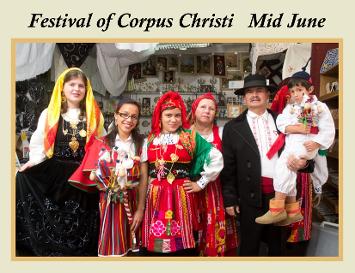THE SPRING EQUINOX
The spring equinox is one of the four great solar festivals of the year. Day and night are equal, poised and balanced, but about to tip over on the side of light. The spring equinox is sacred to dawn, youth, the morning star and the east. The Saxon goddess, Eostre ( from whose name we get the direction East and the holiday Easter ) is a dawn goddess, like Aurora and Eos. Just as the dawn is the time of new light, so the vernal equinox is the time of new life. This is the traditional time for a great spring feast and the decoration of the table is as important as the food. There are many traditions from which to choose: Nawruz, Passover, Easter, St Joseph's Day, Maimuna — all are variations on the theme of the spring feast, in which every item is symbolic.
Major holidays and events during the end of March
NawRuz - *begins at sundown (Baha’i) March 20th
This is the Baha’i New Year, a traditional celebration in Iran adopted as a holy day associated with Baha’i. It is a celebration of spring and new life. “Naw-Ruz has its origins as a Zoroastrian observance in ancient Iran and, to this day, is celebrated as a cultural festival by Iranians of all religious backgrounds. In addition to being celebrated by Iranians and members of the Iranian diaspora, the observance of Naw Ruz has also spread to many other parts of the world, and is celebrated a a cultural holiday in India, Afghanistan, Tajikistan, Iraqi Kurdistan, Azerbaijan, Turkmenistan, Uzbekistan and Kyrgyzstan.”
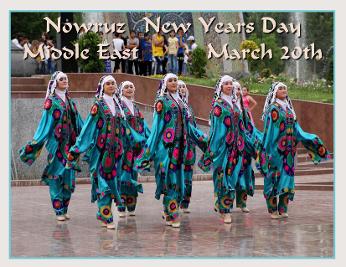
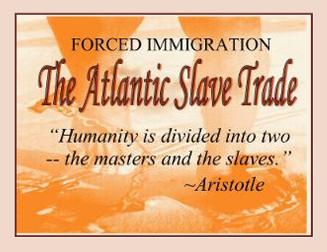
International Day of Remembrance March 25th
International Day of Remembrance of the Victims of Slavery and the Transatlantic Slave Trade
is a United Nations international observance designated in 2007 to be marked on 25 March every year. The day honors and remembers those who suffered and died as a consequence of the transatlantic slave trade, which has been called "the worst violation of human rights in history", in which over 400 years more than 15 million men, women and children were the victims.
The Thimphu Festival, Bhutan 3rd week in March
The ThimphuFestival (Tsechu) is one of the grandest of Bhutan’s festivals ( Buddhist kingdom on the Himalayas’ eastern edged ) attracts the largest audience. Featuring dances performed by trained monks and laymen in amazing masks and costumes, Tsechus (festivals) are one of the best ways to experience the ancient living culture of Bhutan. The Tsehchu is considered a major attraction and people travel from neighboring districts to participate in the festivity. Early in the morning on the last day of the celebration the monks display a gigantic thangkha (embroidered painting) , the Guru Throngdel, inside the dzong. Thongdrols are especially impressive examples of Buddhist art and never fail to amaze viewers. They are considered so sacred that simply seeing a Thongdrol is said to cleans the viewer of sin.
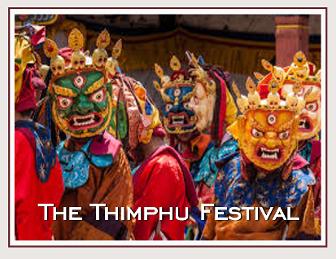
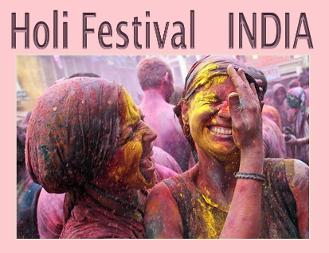
Holi ( Hindu & Sikh Festival ) Mid-March
Holi, a Hindu and Sikh spring religious festival observed in India, Nepal, and Sri Lanka, along with other countries that have large Hindu and Sikh populations. People celebrate Holi by throwing colored powder and water at each other. Bonfires are lit the day before in the memory of the miraculous escape that young Prahlad accomplished when Demoness Holika carried him into the fire.Holi celebrations start on the night before Holi with a Holika bonfire where people gather, sing, dance and party. The next morning is celebrated as Rangwali Holi - a free-for-all carnival of colours,[9] where participants play, chase and colour each other with dry powder and coloured water, with some carrying water guns and coloured water-filled balloons for their water fight.
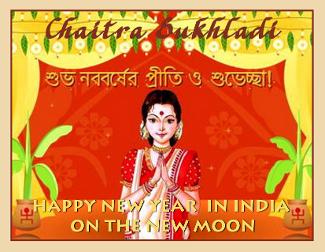
Chaitra Sukhladi Hindu/India ...March New Moon
This is the first day of the Chitra ( spring ) month. In northern parts of India this day is celebrated as Chaitra Sukhladi. In Andhra and Karnataka it is celebrated as Ugadi: Yuga + aadi means start of new era. In Maharashtra and Goa it is celebrated as Gudi Padwa: Padwa means crop; it marks the end of Rabi crop and time for a new 'Vasant'/spring season. Sindhis celebrate the new year as Cheti Chand: Chaitra month is called 'Cheti' in Sindhi; this day is observed as the birthday of Saint Jhulelal. In Kashmir the new year is celebrated as Navreh: the name is derived from Sanskrit 'Nava Varsha' meaning the New Year. In Manipur this day is celebrated as Sajibu Cheiraoba: Sajibu indicates the first of the six seasons and Cheiraoba means declaration of new year.
Major Holidays Near Easter and during the month of April
Qingming Day China April 4th-5th
The day before ( QingMing Day ), Tomb Sweeping Day was the traditional Chinese Cold Food Day. As time passed, the two festivals were gradually combined into one. On the cold food festival day, people used no fire and only ate cold food. Now people in some places still have the custom of eating cold food on Qingming Festival.Different places have different foods for Qingming Festival. The traditional Qingming festival foods include sweet green rice balls, peach blossom porridge, crispy cakes, Qingming snails, and eggs. These foods are usually cooked one or two days before the arrival of the Qingming Festival. A good day to observe blossoms and nature in early spring.

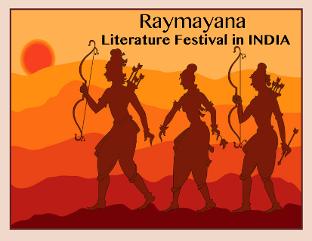
Ramayana ( literature Week ) India April 5th-8th
Thematically, the Ramayana stories explore human values and the concept of dharma. Ramayana Week begins nine days before Ramanavmi or Ram Navami, the birthday of Lord Rama. In North India, the Ramayan week coincides with the Chaitra Navratri. In South India, it is known as the Ramnavami festival and is also celebrated for nine days. In 2016, Ramayana week is from April 8 to April 15, 2016. Many devotees read the entire Ramayana during these nine days. During this period several temples and Hindu spiritual associations organize Akhand Path – non-stop recital – of the great epic Ramayana – the Shri Ramacharitamanas by Goswami Tulsidas. Another important event during this period is the staging of Ram Lila – stage artists narrate the thrilling and exciting episodes from the epic Ramayana.
Buddha's Birthday, Australia, Indonesia and elsewhere April 8th
The Buddha's Birthday is celebrated at Nan Tien Temple in Wollongong Australia and other temples in the Fo Guang Shan Nan Tien Temple group in Australia on the eighth day of the fourth month of the China lunar calendar. In Brisbane there is a weekend-long Buddha Birthday Festival which draws over 200 000 visitors. In Melbourne, the weekend-long Festival is called Buddha's Day and Multicultural Festival. It is held at Federation Square around Apr/May.
http://www.nantien.org.au/buddhas-birthday-festival
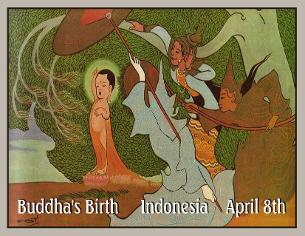
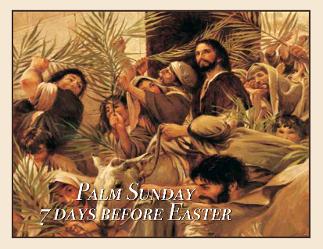
Palm Sunday ...Christian ...Sunday before Easter
Palm Sunday is a Christian moveable feast that falls on the Sunday before Easter. The feast commemorates Jesus' triumphal entry into Jerusalem, an event mentioned in each of the four canonical Gospels.] In many Christian denominations, worship services on Palm Sunday include a procession of the faithful carrying palms, representing the palm branches the crowd scattered in front of Jesus as he rode into Jerusalem. The difficulty of procuring palms in unfavorable climates led to their substitution with branches of native trees, including box, olive, willow, and yew. The Sunday was often named after these substitute trees, as in Yew Sunday, or by the general term Branch Sunday.
Semana Santa Festival Spain Week before Easter
Easter in Valladolid holds ("Semana Santa" in Spanish) is one of the best known Catholic traditions in Valladolid. As a reflection of its importance, is also considered as a Fiesta of International Tourist Interest of Spain since 1981. The Good Friday processions are considered an exquisite and rich display of Castilian religious sculpture. On this day, in the morning, members of the brotherhoods on horseback make a poetic proclamation throughout the city. The "Sermon of the Seven Words" is spoken in Plaza Mayor Square. In the afternoon, thousands of people take part in the Passion Procession, comprising 31 pasos (religious statues), most of which date from the 16th and 17th centuries
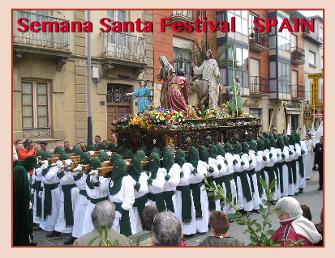
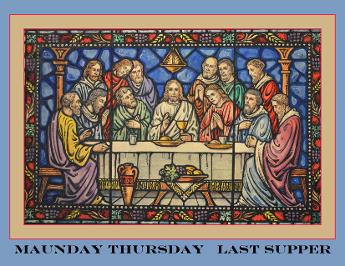
Maunday Thursday Christian Holy Day before Easter Sunday
Maundy Thursday is an alternate name for Holy Thursday, the first of the three days of solemn remembrance of the events leading up to and immediately following the crucifixion of Jesus. The English word "Maundy" comes from the Latin mandatum, which means "commandment." As recorded in John's gospel, on his last night before his betrayal and arrest, Jesus washed the feet of his disciples and then gave them a new commandment to love one another as he had loved them (John 13:34). This is why services on this night generally include the washing of feet or other acts of physical care as an integral part of the celebration.
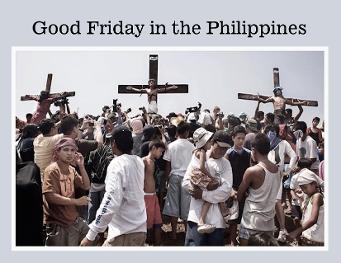
Good Friday Celebration in the Philippines Friday before Easter
The tradition in San Fernando, Pampanga, has its origins in a version of the Passion of the Christ written by a local playwright in the 1950s, which led to the first crucifixion in 1962. It has since grown into one of the most visually striking religious festivals in this part of the world. Catholic leaders in the Philippines condemn the practice, which is also discouraged by public health officials. First-aid personnel are on hand at the events, to help those who collapse from heat and dehydration, or who need their wounds treated.
EASTER Sunday, Christian Holy-Day
March - Mid-April
APRIL 16th 2017, The real meaning of Easter, is the Resurrection of Jesus Christ from the dead. To Christians, it is the most special day of the year. Yes,the birth of Christ is quite important. But, his resurrection offers the hope of everlasting life to everyone! The Lenten season leading up to Easter Sunday is a time of fasting, sacrifice and prayer. It is the christian way of replicating in a small way what Christ sacrificed for us, both in his fasting and his final death on the cross. The word "Easter" comes for the Saxon pagan festival, honoring the goddess "Eastre" (also called Oestre). The goddess Eastre's symbol is the rabbit.Easter also also is celebrated with the Easter Bunny, colored eggs, jelly beans, and lot's of chocolate. He (or she, as we are never quite sure about this) comes on Saturday night leading to Easter Sunday morning. He brings lots of chocolates and other candies. That's one meaning to Easter, especially if you are a kid or a "Chocoholic".
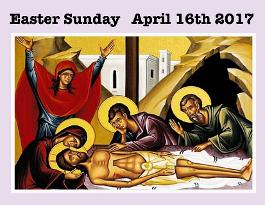
Radonitsa Belarus-Orthodox 2nd Tuesday after Easter
(Russian Радоница, "Day of Rejoicing"), also spelled Radunitsa, Radonica, or Radunica, in the Russian Orthodox Church is a commemoration of the departed observed on the second Tuesday of Pascha (Easter) or, in some places ( in south-west Russia), on the second Monday of Pascha. Among the traditions that have grown up around Radonitsa, the following are noteworthy. Foods traditionally eaten at Radonitsa are: funeral kutia, painted eggs, kulichi, pancakes, dracheni, honey prianiki, and cookies. Radonitsa begins the marriage season. Since weddings are forbidden during the Great Lenten Fast (because that time should be devoted to penance and self-examination, rather than merrymaking), as well as during Bright Week (because at that time we commemorate nothing else except the Resurrection), with Radonitsa comes the time for weddings. Men and women traditionally give gifts to their in-laws (more kindly known as "God-given" family members), at Radonitsa, so that joy may be in every house.
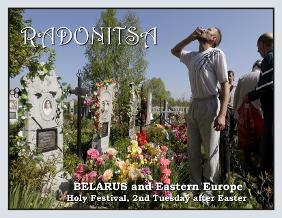
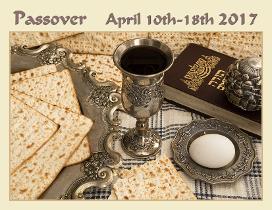
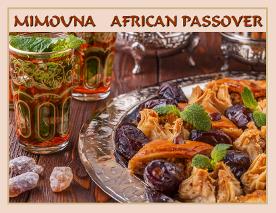
Passover Jewish holy day International Late March - April
PASSOVER begins APRIL 10th-18th 2017 ( late March or in April ) Festival celebrating the Hebrews captivity in Egypt at the time when God commanded Moses to ask for the Hebrew people to be released. As a result of being denied 10 plagues came open Egypt. One being the Angel of death coming and the first born son of each home dying. But God commanded the Hebrews to apply lambs blood to the door posts as a sign for the Angel to pass that house. In the Israel, Passover is the seven-day holiday of the Feast of Unleavened Bread, with the first and last days observed as legal holidays and as holy days involving abstention from work, special prayer services, and holiday meals; the intervening days are known as Chol HaMoed ("Weekdays [of] the Festival"). Diaspora Jews historically observed the festival for eight days, and most still do. Reform and Reconstructionist Jews and Israeli Jews, wherever they are, usually observe the holiday over seven days. The reason for this extra day is due to enactment of the ancient Jewish sages.
Mimouna ...African Passover ...late April 2017
Mimouna is a Moroccan-Jewish post-Passover festival that takes place immediately after the close of the Passover holiday at sundown. Mimouna is a celebration of community, friendship, and hospitality and also commemorates the miracle that G-d granted the Jews at the "Red Sea" ("Yam Suf" in Hebrew) when they were fleeing the Egyptian army. Moroccan-Jewish families invite relatives and friends and other guests over to each other's houses and there is a sweet table covered in a white tablecloth that is set up in each house that serves as the centerpiece for the Mimouna festival.
Dyngus Day ...Christian Event ...Monday after Easter
The celebration has been traced back to the 14th century but may have earlier, pre-Christian origins involving the celebration of the March equinox. The origins of the word dyngus are obscure; it may come from the German Dingeier ( "the eggs that are owed" ) or Dingnis ( "ransom" ). The occurrence of the celebration across the western Slav countries ( plus Hungary, whose inhabitants' forebears conquered a region that was inhabited by Slavs ) suggests a common origin in pagan mythology, most likely a link with the Slavic goddesses of fertility. Dyngus Day is observed in many Polish American communities, most notably in Buffalo, New York, which hosts the largest continuing event commemorating the day. The Buffalo dyngus celebrations only started in the 1960s as an effort by the Polish-American community in the city to find a new focus for its identity. It proved hugely successful, to the point that a local newspaper claimed that "everybody is Polish on Dyngus Day." It has become a fusion of Polish and American traditions, with polka bands, a parade, consumption of krupnik and Polish food accompanying American patriotic songs sung in English. Party-goers dress up in the white-and-red colors of the Polish flag and carry balloons saying "Happy Dyngus Day" in English.
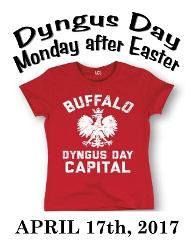
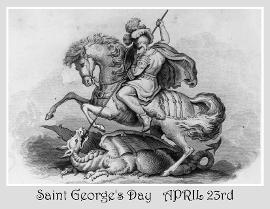
Saint George's Day Christian April 23rd
St George is most widely known for slaying a dragon. According to legend, the only well in the town of Silene was guarded by a dragon. In order to get water, the inhabitants of the town had to offer a human sacrifice every day to the dragon. The person to be sacrificed was chosen by lots. On the day that St George was visiting, a princess had been selected to be sacrificed. However, he killed the dragon, saved the princess and gave the people of Silene access to water. St George's Day used to be a national holiday in England. It is now an observance that is celebrated with parades, dancing and other activities. Flags with the image of St George's cross are flown on some buildings, especially pubs, and a few people wear a red rose on their lapel. Church services on the Sunday closest to April 23 often include the hymn 'Jerusalem', written by the poet William Blake. The words describe a supposed visit to Glastonbury, England, by Jesus Christ during his youth.

International Earth Day Celebrations April 22
Earth Day is an annual event, celebrated on April 22, on which day events worldwide are held to demonstrate support for environmental protection. It was first celebrated in 1970, and is now coordinated globally by the Earth Day Network, and celebrated in more than 192 countries each year.
http://www2.erie.gov/environment/index.php?q=rain-barrel-contest
Major holidays during the month of May
Yom Ha'Atzmaut Israel's Independence Day Jewish calendar -May
MAY 2nd, 2017 ...Many Jewish Americans celebrate Israel’s independence on Yom Ha’Atzmaut. It commemorates when David Ben-Gurion, who was Israel’s first prime minister, publicly read the Israel’s Declaration of Independence on May 14, 1948. According to the Jewish calendar, this was the fifth day of Iyar, the eighth month of the civil year, in the year 5708. According to the Jewish calendar, the fifth day of the month of Iyar cannot fall on a Sunday. If this date falls on a Friday or Saturday, Yom Ha'Atzmaut is observed on the third or fourth day of the month. If the date falls on a Monday, it is observed on the sixth day of Iyar. This is so that the festivities do not fall just before, on, or just after the Sabbath.
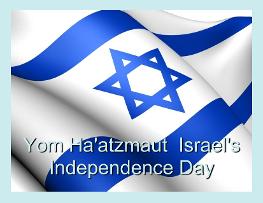
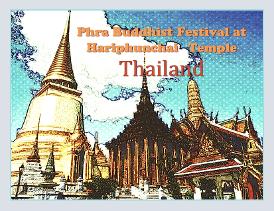
PHRA Fest at Hariphunchai Temple ...Buddhist ...Early May
Phra That Hariphunchai Temple was built during the reign of King Arthitayarat, a descendant of Queen Chamthewi some 800 years ago. Holy relics were enshrined in a massive 46-metre tall golden Chedi called Phra That Hariphunchai whose present appearance was the result of the restoration work in 1443 by a king of Chiang Mai. To pay homage to one of the most sacred monuments in Northern Thailand, Song Nam Phra That Hariphunchai festival has long been held and attracts Buddhists in Lamphun and nearby provinces as well as visitors. Besides the religious ceremony, also included are cultural performance, giant drum competition, sacred water pilgrimage and nail-covered dance shows .
The Wesak Buddhist Full Moon Festival ...May Full Moon
The Wesak Festival is generally known as the Festival of the Buddha. In a legend, full of imagery, He is said to make an annual appearance in a secluded valley somewhere in the Himalayas at the exact time of the full moon of Taurus. He appears for a brief period and enacts a water ceremony before his great brother, the Christ, and an assembly of adepts and disciples. The potency of the Buddha’s presence is such that it cannot be endured for long by the assembled group. The moment of His approach is characterized by a great Silence, said to be brimming with vitality and significance. The Buddha’s blessing, stepped down by the Christ, is radiated throughout the gathering and into the world.
https://allevents.in/calcutta/wesak-festival-2016/1047873571921451#

St. Epiphanius of Salamis Day, Catholic April 12th
The "Oracle of Palestine' the bishop of Constantia, Salamis, Cyprus. He was born in Besanduk, Palestine, in 315, and he became an expert in scriptural languages. He spent time as a monk and as a hermit. In 333, he was ordained and made the abbot of a monastery at Eleutheropolis. He became the bishop of Cyprus in 367, a foe of the Arians. After a series of disputes, Epiphanius concentrated on writing. He was an authority on Mary and taught the primacy of Peter among the Apostles. He is considered an outstanding Church defender.http://www.zicasso.com/luxury-vacation-cyprus-greece-tours/best-greece-cyprus-vacation
Major holiday and festival events during the first ( 3 ) weeks of june
Shavuot ( Jewish Festival ) Late may - Early June
May 30th-June 1st 2017 Shavuot is not explicitly named as the day on which the Torah was revealed by God to the Israelite nation at Mount Sinai in the Bible, although this is commonly quoted to be its main significance.What is indeed textually connected in the Bible to the Feast of Shavuot, is the season of the grain harvest, specifically of the wheat, in the Land of Israel. In ancient times, the grain harvest lasted seven weeks and was a season of gladness (Jer. 5:24, Deut. 16:9-11, Isa. 9:2). It began with the harvesting of the barley during Passover and ended with the harvesting of the wheat at Shavuot. Shavuot was thus the concluding festival of the grain harvest, just as the eighth day of Sukkot (Tabernacles) was the concluding festival of the fruit harvest. During the existence of the Temple in Jerusalem, an offering of two loaves of bread from the wheat harvest was made on Shavuot.
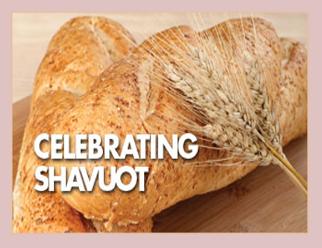
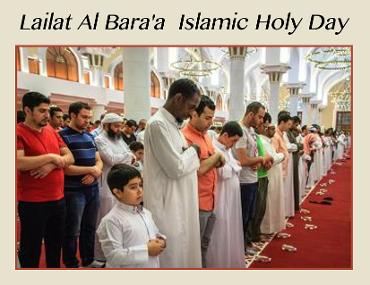
Lailat al Bara'a Muslim holy day International
( 2 weeks before Ramadan )
Lailat al Bara'a - the Night of Forgiveness - takes place two weeks before the beginning of Ramadan. On this night, Muslims pray and ask God for forgiveness for their sins either at the mosque or at home. They believe that on this night one’s destiny is fixed for the year ahead. Visiting the graves of relatives and giving to charity is traditional at this time.Mid-Sha'ban is celebrated in countries including India, Pakistan, Bangladesh, Sri Lanka, Lebanon, Iran, Azerbaijan, Turkey, Uzbekistan, Tajikistan, Kazakhstan, Turkmenistan and Kirghistan. The Salafi Arabs do not celebrate this holiday. In the Arab world the festival is celebrated by Arabs with Sufi heritage, and Shias. In Iraq, children are given candies as they walk around their neighborhoods. Sunni Muslims in Iraqi Kurdistan and Afghanistan celebrate this holiday 15 days before Ramadan.
Ramadan ...Islam ...Islamic Calendar, May 27th - June 25th 2017
Ramadan is the holiest month in the Islamic calendar, during which, for a period of thirty days, Muslims abstain from eating, and drinking from sunrise to sunset. Muslims do this because it is a pillar of Islam, and obligatory for everyone. In other words, God decreed this entire time period holy for Muslims so that they can increase their remembrance of life after death. The practice of Islam also requires a abstain from all bad deeds and habits, like smoking, swearing, and acting disrespectful. Individuals reflect upon themselves, their religion, and the characteristics of God. Fasting during Ramadan is one of the five pillars of Islam. Fasting and abstaining from bad habits teaches methods of self control, humility, and generosity. Ramadan is a time for charity, family, and good deeds. Muslims fast because they believe it is vital for spiritual health. Unlike the fast of Ashurah, the fasts of Ramadan are declared mandatory by God because like salah ( praying towards Mecca ), fasting helps maintain spiritual and physical health. The month of Ramadan begins when the new moon of Ramadan is sighted and ends when the new moon of Sha'ban is sighted.
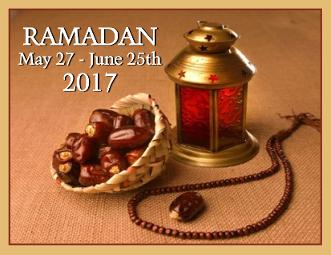
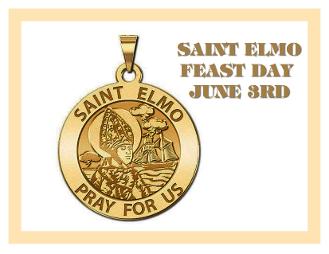
Feast Day of Saint Elmo ...Christian ...June 3rd
The Feast Day of Saint Elmo is June 3rd. Most saints have specially designated feast day and are associated with a specific day of the year and these are referred to as the saint's feast day. The feast days first arose from the very early Christian custom of the annual commemoration of martyrs on the dates of their deaths at the same time celebrating their birth into heaven. Saint Erasmus of Formia, also known as Saint Elmo, was a Christian saint and martyr, according to Christian tradition, who died c. 303. He is venerated as the patron saint of sailors and abdominal pain. Saint Erasmus may have become the patron of sailors because he is said to have continued preaching even after a thunderbolt struck the ground beside him. This prompted sailors, who were in danger from sudden storms and lightning, to claim his prayers. The electrical discharges at the mastheads of ships were read as a sign of his protection and came to be called "Saint Elmo's Fire"
Martyr's Day ...Uganda ...June 3rd
Uganda Martyrs' Day Celebrations are held every 3rd June at the Uganda Martyrs' Shrine, Namugongo, Kampala-Uganda. In Uganda, this day is a public holiday, which gives chance to millions of people from near and far to make pilgrimage to this Holy Land. The Martyrs' Day celebrations begin with a Novena in various parts of the country especially in places where different Martyrs were either born or killed. The Novena begins from 25th May to 2nd June. The Novena at Namugongo is also attended by pilgrims from neighboring countries like; Kenya, Tanzania, Rwanda, Burundi, Democratic Republic of Congo and from some other continents. Many of these pilgrims, young and old, walk miles and miles from their home areas up to Namugongo as a sign of honor to the Martyrs who shed their blood for the sake of our Lord Jesus Christ. Pilgrims also spend weeks on this long journey trying to invoke the Uganda Martyrs to intercede for them in overcoming their problems.
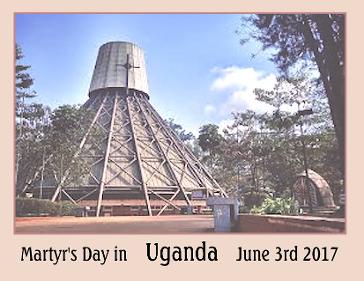
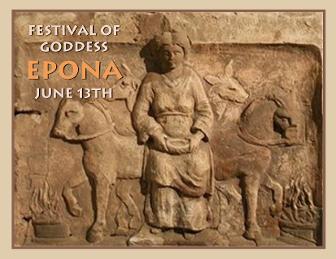
Festival of goddess Epona Celtic International
June 13th
Known as Rhiannon in Wales, Macha in Ireland, and Epona to the Gauls this ancient horse goddess is one of the most well-known of all the Celtic gods and goddesses. Horses played an important role in Celtic society. Naturally, the protector of horses would play an equally important role. Epona has been revered since the Iron Age. She is the protector of horses, stables, and horse owners. She is the guardian of agriculture and transportation.
Festival of Corpus Christi ...Christian ...June 15th
Corpus Christi is a Christian observance that honors the Holy Eucharist. It is also known as the Feast of the Most Holy Body of Christ, as well as the Day of Wreaths. Corpus Christi is a festival that has been celebrated by many Christians, particularly the Catholic Church, in honor of the Eucharist since 1246. The name “Corpus Christi” is a Latin phrase that refers to the body of Christ. It is a moveable feast that is celebrated on the Thursday after Trinity Sunday or on the Sunday after Holy Trinity in some countries such as the United States. This event commemorates the Last Supper on the day before Jesus’ crucifixion, as described in the Bible. Corpus Christi is primarily celebrated by the Roman Catholic Church but it is also included in the calendar of some Anglican churches.
